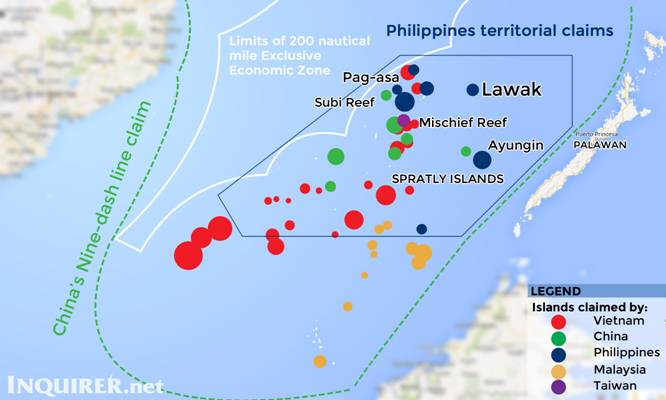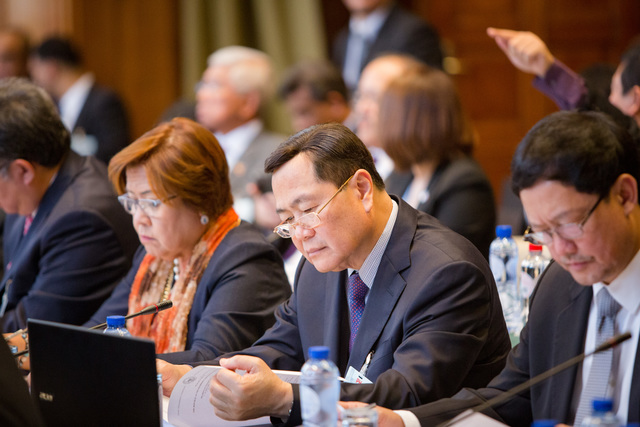Philippines’ President Benigno Aquino III will discuss the disputes over the West Philippine Sea (South China Sea) and steps on further strengthening the long-standing economic and defense relations between the Philippines and the United States during his meeting with US President Barrack Obama in Bali, Indonesia where the 19th Association of Southeast Asian Nations (Asean) Summit is being held.
The President left at around 8 a.m. on Thursday for Indonesia from the tarmac of the 250th Presidential Airlift Wing at the Villamor Airbase in Paranaque City (Metro Manila).
In his pre-departure speech, the President cited the importance of the regional bloc, which was established in 1967 and is aimed at the "creation of a cohesive, peaceful, stable and resilient region".
In a press briefing at the Courtyard Mariott Bali Nusa Dua Hotel, Presidential Communications Development and Strategic Planning Office Secretary Ramon Carandang said that the United States has been exerting efforts to re-engage itself with the countries in the Asia-Pacific region, including the Philippines, which the world superpower considers as important partners in economic and political development.
"I think what's very clear is that the United States wants to re-engage itself in the Asia Pacific region, especially now that they're winding down their commitments to other parts of the world.
The Asia-Pacific region has become much more important to them economically and politically. And what we're seeing are manifestations of that increased importance that Asia-Pacific, including the Philippines, is taking and I am sure the discussions between the two leaders will hew to that general theme," he said.
When asked if the Philippines will seek security assistance from the United States on the dispute in the West Philippine Sea, Carandang said that the government has been considering that.
"I think we've been doing what we can already with the West Philippine Sea issue and the American presence here, and the fact that they agree with our position is something that we find helpful," he said.
Carandang added that the government welcomes any assistance from the US, specifically in increasing the maritime defense capabilities of the Philippines.
The bilateral talk betweens President Aquino and Obama is scheduled on Friday as part of the 19th Asean Summit and Related Summits.
Also attending the event are the heads of state of Asean's dialogue partners including Chinese Premier Wen Jiabao, Australian Prime Minister Julia Gillard, Japanese Prime Minister Yoshihiko Noda and United Nations Secretary General BanKi-moon, among others.
The Asean will widen on Saturday into the East Asia Summit which takes in Australia, China, India, Japan, South Korea and New Zealand, and this year welcomes the United States and Russia.
A major issue
The maritime dispute with China and a debate over whether to reward Myanmar for fledgling reforms are expected to dominate talks during the 19th Asean Summit.
With the eurozone lurching through a debt crisis, raising the specter of Asean's export markets drying up, there is also pressure on the 10-member bloc to speed up the integration of its potentially huge common market.
Obama is coming to Bali as the US rolls out a diplomatic campaign to assert itself as a Pacific power, including plans for up to 2,500 Marines to be deployed in Australia.
Its more robust role, which smaller Asian states welcome as a counterbalance to China, has caused friction with the two powers trading warnings that set the stage for a confrontation at the East Asia Summit.
The US has signaled that it will raise the issue of China's territorial claims over the West Philippine Sea, with its strategic shipping lanes and rich oil and mineral reserves, despite Beijing saying that the topic should be off-limits.
Secretary of State Hillary Clinton said on Wednesday on a visit to the Philippines, which along with Vietnam has complained that China is becoming more aggressive in asserting its claims, that threats were unacceptable.
"Any nation with a claim has a right to exert it, but they do not have a right to pursue it through intimidation or coercion," she said.
The Philippines, which has led calls for ASEAN to build a united front against China over the dispute, was slammed by China's state-run Global Times on Thursday, which said that it should be punished with trade boycotts and travel bans.
"The way that China punishes the Philippines should not be overdone or elicit regional fears toward China, but it must make the Philippines pay the price," said the paper, known for its nationalistic stance.
Diplomats in Bali have expressed concern that Southeast Asian nations may get squeezed between the competing interests of the two big world powers.
"We must ensure the stability and security of our region," Indonesian President Susilo Bambang Yudhoyono said in an opening speech.
"Asean must continue to play a proactive role to facilitate and engage itself in the resolution of issues," he said in an apparent reference to the West Philippine Sea dispute.
Bali, a resort island that is normally a haven for tourism and relaxation, has been transformed for the event, with six warships patrolling off the beaches and 7,000 police and soldiers providing a blanket security presence.
Myanmar issue
The Asean summit also sees the diplomatic debut of Myanmar's new military-backed government, which has surprised observers with a string of conciliatory moves since it was sworn in eight months ago.
The leaders are set to formally approve a plan to allow Myanmar to chair the regional bloc in 2014, despite objections from the United States which said that it was premature.
Myanmar's Information Minister Kyaw Hsan called on the US to recognize what he said were "irreversible" reforms and abandon its economic sanctions, in an interview with the Wall Street Journal published on Thursday.
Kyaw Hsan blamed the sanctions for the country's lack of development and said that they forced Myanmar to be reliant on Chinese companies.
"When we are striving for development, we cannot be choosers -- we have accepted what is best for the country," he added.
The nominally civilian government has held direct talks with opposition leader Aung San Suu Kyi, freed 200 dissidents, frozen work on an unpopular mega-dam and passed a law giving workers the right to strike.
But rights campaigners say those measures could easily be reversed and that handing Myanmar the diplomatic prize could remove the incentive for more fundamental change in a nation still accused of serious rights abuses.
Asean's leaders will also review stuttering progress on an ambitious plan for a common and barrier-free market by 2015, a task made more urgent by the crisis in major export markets in Europe.
The gaps between the region's economies--which range from the wealthy city-state of Singapore to underdeveloped Laos and Myanmar -- are a formidable barrier to establishing a common market of more than 600 million people.
But Indonesian Trade Minister Gita Wirjawan said on Wednesday that the economic woes in Europe and the US presented an opportunity for Asean to "behave more collectively".


































